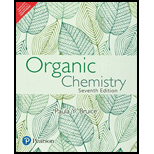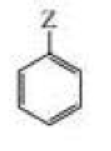
Organic Chemistry - MasteringChemistry
7th Edition
ISBN: 9780321867148
Author: Bruice
Publisher: PEARSON
expand_more
expand_more
format_list_bulleted
Concept explainers
Textbook Question
Chapter 19, Problem 50P
For each of the statements in Column I, choose a substituent from Column II that fits the description for the compound on the right:
| Column I | Column II |
| a. Z donates electrons by hyperconjugation and does not donate or withdraw electrons by resonance. | OH |
| b. Z withdraws electrons inductively and withdraws electrons by resonance. | Br |
| c. Z deactivates the ring and directs ortho-para. | +NH3 |
| d. Z withdraws electrons inductively, donates electrons by resonance, and activates the ring. | CH2CH3 |
| e. Z withdraws electrons inductively, and does not donate or electrons by resonance. | NO2 |

Expert Solution & Answer
Want to see the full answer?
Check out a sample textbook solution
Students have asked these similar questions
For the 6-carbon molecule below, how would you expect it to break into two pieces?
a. two 3-carbon units
b. one 2-carbon unit and one 4-carbon unit
c. one 1-carbon unit, one 2-carbon unit, and one 3-carbon unit
d. one 1-carbon unit and one 5-carbon unit
I'm having a hard time identifying the correct location of Beta and Alpha. If the carbonyl beta is the second bond over from carbonyl, then the breakage would occur at bond C3-C4. This would then result in two 3-carbon units, right? The molecule in the image looks like fructose which would result in two 3-carbon units.
In RPLC, consider this statement: Compound A is more polar than compound B. In which column will compound A be more retained than compound B?
A. C18
B. C8
C. Phenyl-bonded column
D. All of the Above
E. Neither of the choices
The sub-part that needs to be solved...
4. When propanal undergoes continued oxidation, it yields:
A. Propanol
B. Propanoic acid
C. Propanone
D. No reaction
5. The _______ test, also called the silver mirror test, involves a solution that contains silver nitrate (AgNO3) and ammonia (NH3) in water.
A. Tollen's
B. Benedict's
C. Tollens
D. Benedicts
Chapter 19 Solutions
Organic Chemistry - MasteringChemistry
Ch. 19.1 - Draw the structure for each of the following: a....Ch. 19.2 - PROBLEM 2
If electrophilic addition to benzene is...Ch. 19.4 - Why does hydration inactivate FeBr3?Ch. 19.6 - Prob. 5PCh. 19.7 - Prob. 6PCh. 19.8 - What is the major product of a Friedel-Crafts...Ch. 19.10 - Describe two ways to prepare each of the following...Ch. 19.12 - Prob. 9PCh. 19.13 - Name the following:Ch. 19.13 - Prob. 12P
Ch. 19.13 - Prob. 13PCh. 19.13 - Prob. 14PCh. 19.14 - Prob. 15PCh. 19.14 - List the compounds in each set from most reactive...Ch. 19.15 - Prob. 18PCh. 19.15 - What product(s) result from nitration of each of...Ch. 19.15 - Prob. 20PCh. 19.16 - Which acid in each of the following pairs is...Ch. 19.16 - Prob. 23PCh. 19.16 - Prob. 24PCh. 19.18 - Show how the following compounds can be...Ch. 19.18 - Give the products, if any, of each of the...Ch. 19.19 - a. Does a coupling reaction have to be used to...Ch. 19.19 - PROBLEM 28
Show how each of the following...Ch. 19.20 - What is the major product(s) of each of the...Ch. 19.20 - Prob. 30PCh. 19.21 - Why isn't FeBr3 used as a catalyst in the first...Ch. 19.21 - Prob. 33PCh. 19.21 - Write the sequence of steps required for the...Ch. 19.21 - Prob. 35PCh. 19.22 - What product is formed from reaction of...Ch. 19.22 - Prob. 37PCh. 19.22 - Draw the structure of the activated ring and the...Ch. 19.23 - Prob. 39PCh. 19.23 - Prob. 40PCh. 19.23 - Diazomethane can be used to convert a carboxylic...Ch. 19.24 - Prob. 42PCh. 19.24 - Prob. 43PCh. 19.24 - Prob. 44PCh. 19.25 - Prob. 45PCh. 19 - Draw the structure for each of the following: a....Ch. 19 - Prob. 47PCh. 19 - Prob. 48PCh. 19 - Prob. 49PCh. 19 - For each of the statements in Column I, choose a...Ch. 19 - What product is obtained from the reaction of...Ch. 19 - Draw the product(s) of each of the following...Ch. 19 - Rank the following substituted anilines from most...Ch. 19 - Prob. 54PCh. 19 - The compound with the 1H NMR spectrum shown below...Ch. 19 - Prob. 56PCh. 19 - Show how the following compounds can be...Ch. 19 - Prob. 58PCh. 19 - Rank each group of compounds from most reactive to...Ch. 19 - Prob. 60PCh. 19 - Describe two ways to prepare anisole from benzene.Ch. 19 - For each of the following components, indicate the...Ch. 19 - Prob. 63PCh. 19 - Prob. 64PCh. 19 - Prob. 65PCh. 19 - Prob. 66PCh. 19 - An aromatic hydrocarbon with a molecular formula...Ch. 19 - The following tertiary alkyl bromides undergo an...Ch. 19 - Show how the following compounds can be...Ch. 19 - Use the four compounds shown below to answer the...Ch. 19 - a. Rank the following esters from most reactive to...Ch. 19 - A mixture of 0.10 mol benzene and 0.10 mol...Ch. 19 - Prob. 73PCh. 19 - Benzene underwent a Friedel-Crafts acylation...Ch. 19 - Prob. 75PCh. 19 - Prob. 76PCh. 19 - Prob. 77PCh. 19 - Friedel-Crafts alkylations can be carried out with...Ch. 19 - Show how the following compounds can be prepared...Ch. 19 - Prob. 80PCh. 19 - Prob. 81PCh. 19 - a. Describe four ways the following reaction can...Ch. 19 - Propose a mechanism for each of the following...Ch. 19 - Prob. 84PCh. 19 - Describe how naphthalene can he prepared from the...Ch. 19 - Prob. 86PCh. 19 - Using resonance contributors for the carbocation...Ch. 19 - Prob. 88PCh. 19 - When heated with chromic acid, compound A forms...Ch. 19 - Prob. 90PCh. 19 - Prob. 91PCh. 19 - What reagents are required to carry out the...Ch. 19 - Show how the following compounds can be prepared...Ch. 19 - An unknown compound reacts with ethyl chloride and...Ch. 19 - How can you distinguish the following compounds...Ch. 19 - P-Fluoronitrobenzene is more reactive toward...Ch. 19 - a. Explain why the following reaction leads to the...Ch. 19 - Describe how mescaline can be synthesized from...Ch. 19 - Propose a mechanism for the following reaction...Ch. 19 - Explain why hydroxide ion catalyzes the reaction...Ch. 19 - Propose a mechanism for each of the following...Ch. 19 - Prob. 102PCh. 19 - Prob. 103PCh. 19 - Describe how 3-methyl-1-phenyl-3-pentanol can he...Ch. 19 - a. How can aspirin be synthesized from benzene? b....Ch. 19 - Prob. 106PCh. 19 - Show how Novocain, a painkiller used frequently by...Ch. 19 - Prob. 108PCh. 19 - Saccharin, an artificial sweetener, is about 300...
Knowledge Booster
Learn more about
Need a deep-dive on the concept behind this application? Look no further. Learn more about this topic, chemistry and related others by exploring similar questions and additional content below.Similar questions
- How to approach this problem?arrow_forwardWhy does the methyl on the right have higher priority than the ethyl on the right when labeling the molecule as an E or Z isomer?arrow_forwardConsider the hydrogenation reaction below, which replaces all with the appropriate number of carbon-to-hydrogen bonds C10H12+3H2 = C10H18 Assuming 100% hydrogenation, how many rings are present in C10H12?arrow_forward
- What is going on from compound B to compound C? Can you please select all the options that applyarrow_forwardThe Hammett analyses have been done on two substrates which obtain a rho value of 3.8. from the correlation with positive sigma constants (A) while the other set of substituents (B). has a rho value of -2 using the regular sigma values: part a) identify which rho value matches the substituents using resonance as an argument.arrow_forwardA student was randomly given compounds E and F from the group of compounds below and asked to identify them according to their functional group. The student initially thought this to be easy, only to discover that he was embarking on some kind of Herculean task. If you were to correctly advise the student, which test will be most appropriate to distinguish compounds E and F? A. Brady's test (2,4-DNP) B. Reaction with Jones's reagent C. Tollen's test D. Iodoform testarrow_forward
- TRUE OR FALSE. Write T if True, F if False. 1. In numbering the longest chain, the first substituent should have the higher number. 2. Alphabetize the names of the substituents, ignoring all prefixes except iso, as in isopropyl and isobutyl. 3. A number is always designated to indicate the location of a single substituent in cyclohexane. 4. For rings with two different substituents, number the ring to assign the lower number to the substituents alphabetically. 5. In naming alkenes, the longest carbon chain is always used as the parent name. 6. Toluene is an IUPAC name. 7. A benzyl group differs from a phenyl group only by an extra CH2 group. 8. Naming of branched molecules depend on the type of C atom removed from the parent chain. 9. An unbranched alkane with a chain of 50 carbons is called pentacontane. 10. Heterocyclic amines still…arrow_forwardTrue or False 1. Liebermann-Burchard Test -Color change is due to increasing conjugation of the double bond in adjacent fused ring 2. Liebermann-Burchard Test -Acetic anhydride reacts with the aliphatic hydrocarbon. 3. Salkowski Test - The chloroform layer turns red. 4. Salkowski Test - Involves the reagents chloroform, sulfuric acid and acetic anhydride 5. Liebermann-Burchard Test -Reaction involved is esterification. 6. Keller-Killiani Test - Involves color reaction of the sugar 2-deoxyhexose 7. Salkowski Test - The upper layer turns yellow with green fluorescence 8. Liebermann-Burchard Test -Must observe the color right away because it happens in a very short period of time. 9. Liebermann-Burchard Test - Chloroform was added to react with sulfuric acid. 10. Keller-Killiani Test - Color change results to reddish brown that turns into violet or purplearrow_forwarda. Can you predict an undesirable side reaction that might occur using ethanol as a solvent that would not occur if we used THF as a solvent?b. Based on your knowledge of SN2 reactions, what would happen if we used 1-ethyl-2- naphthoxide instead of 2-naphthoxide? Explain.arrow_forward
- Why is the reaction of the type shown below usually done? a.To make an aldehyde or ketone less water soluble b.To make the molecule more reactive c.To protect a ketone or aldehyde carbonyl d.To increase the oxygen content e.To make the alpha hydrogens more acidicarrow_forwardRank the following groups in order of decreasing priority according to the Cahn-Ingold-Prelog system. I) -CH=CH2 II) -CH3 III) -CH IV) -OH 1) IV > III > I > II 2) IV > I > III > II 3) III > IV > I > II 4) II > I > III > IVarrow_forwardRank the following groups in order of decreasing priority. −F, −NH2, −CH3, −OHarrow_forward
arrow_back_ios
SEE MORE QUESTIONS
arrow_forward_ios
Recommended textbooks for you
 Organic Chemistry: A Guided InquiryChemistryISBN:9780618974122Author:Andrei StraumanisPublisher:Cengage Learning
Organic Chemistry: A Guided InquiryChemistryISBN:9780618974122Author:Andrei StraumanisPublisher:Cengage Learning

Organic Chemistry: A Guided Inquiry
Chemistry
ISBN:9780618974122
Author:Andrei Straumanis
Publisher:Cengage Learning
General Chemistry | Acids & Bases; Author: Ninja Nerd;https://www.youtube.com/watch?v=AOr_5tbgfQ0;License: Standard YouTube License, CC-BY